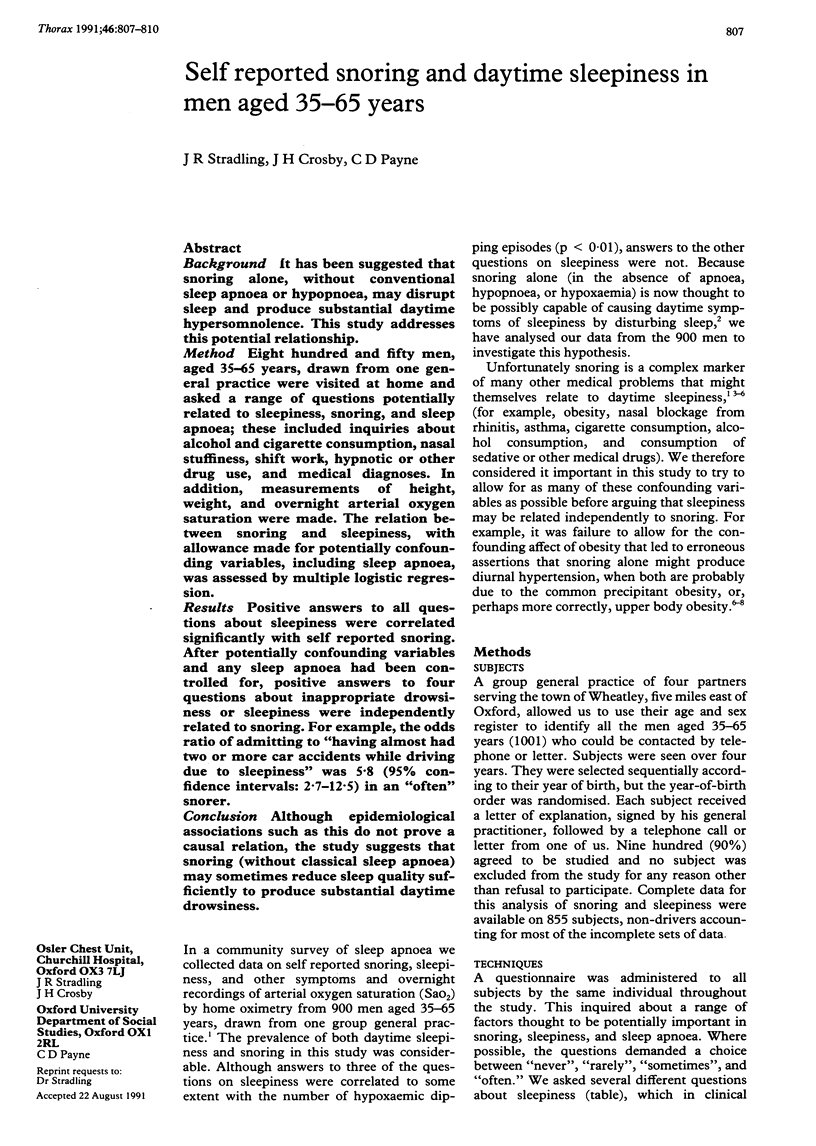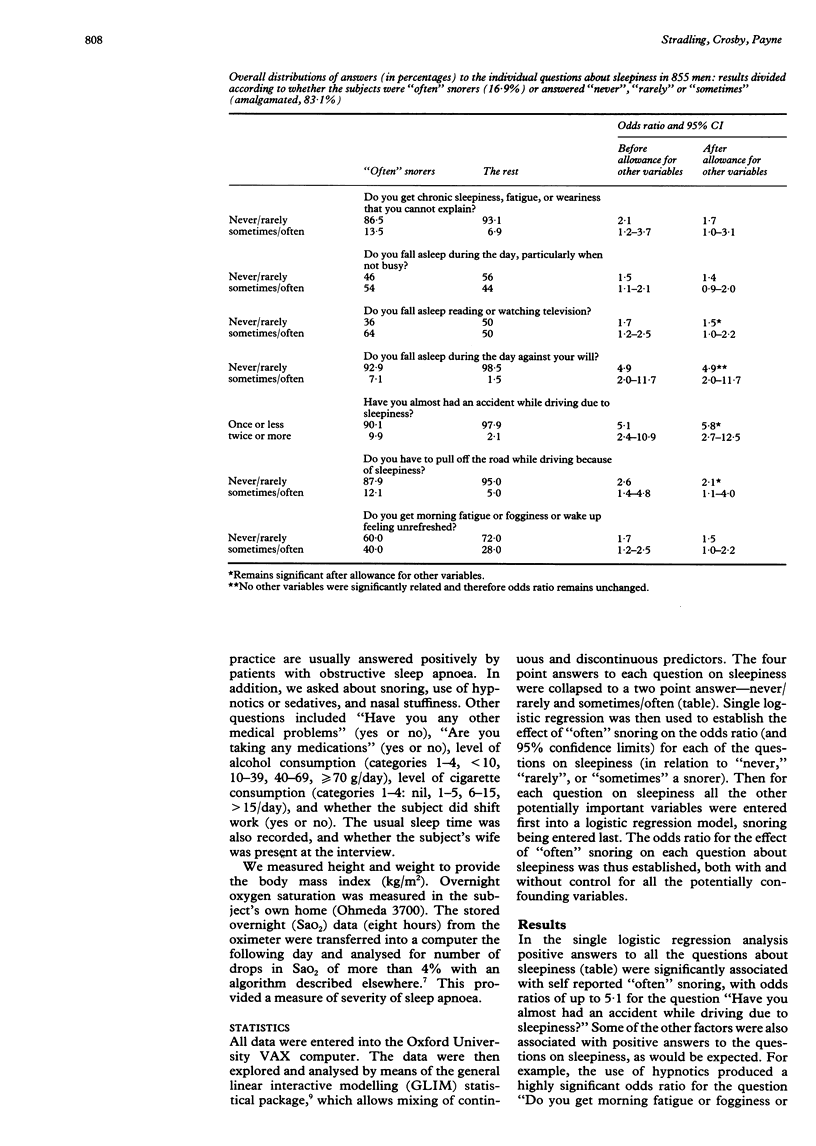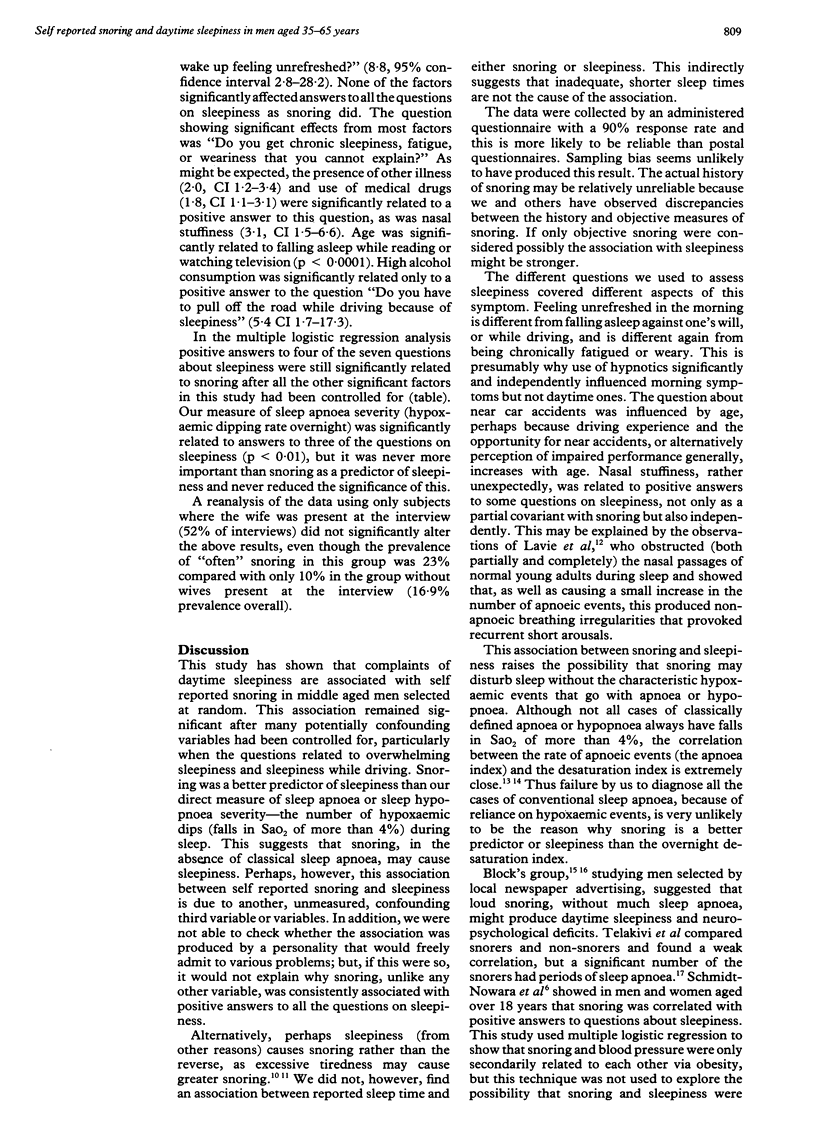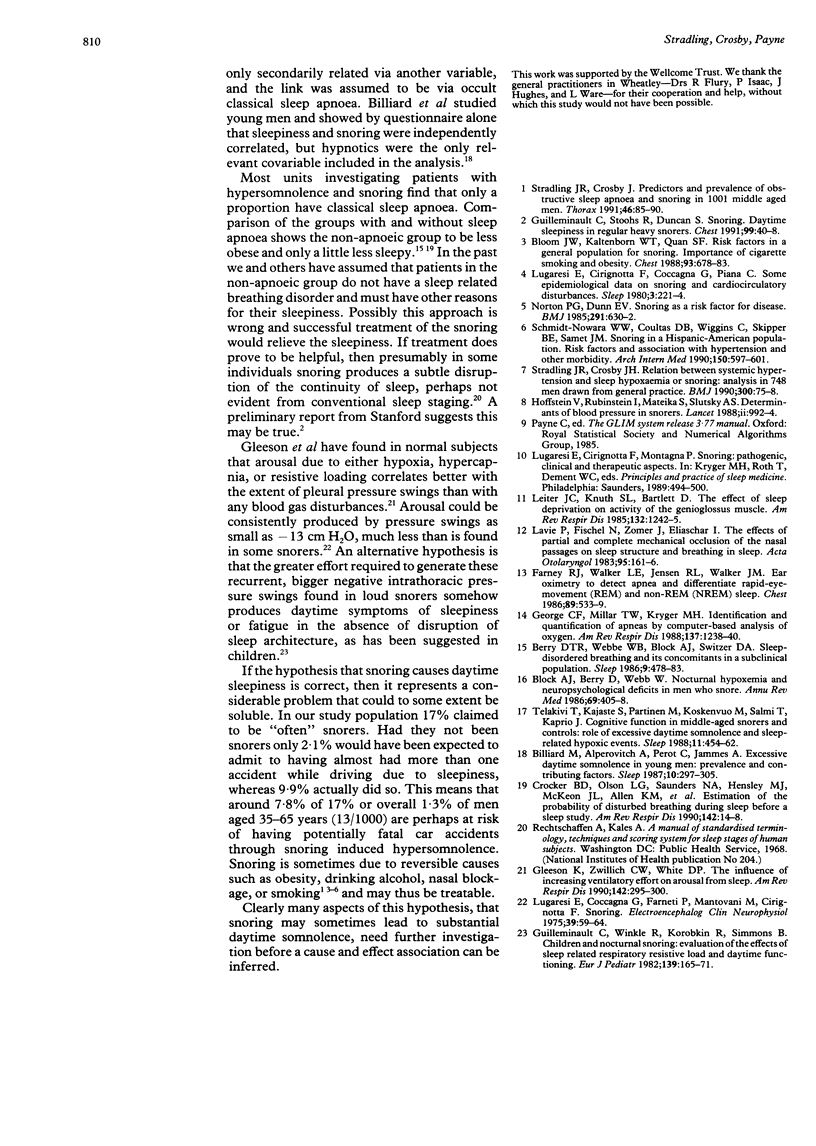Abstract
BACKGROUND: It has been suggested that snoring alone, without conventional sleep apnoea or hypopnoea, may disrupt sleep and produce substantial daytime hypersomnolence. This study addresses this potential relationship. METHOD: Eight hundred and fifty men, aged 35-65 years, drawn from one general practice were visited at home and asked a range of questions potentially related to sleepiness, snoring, and sleep apnoea; these included inquiries about alcohol and cigarette consumption, nasal stuffiness, shift work, hypnotic or other drug use, and medical diagnoses. In addition, measurements of height, weight, and overnight arterial oxygen saturation were made. The relation between snoring and sleepiness, with allowance made for potentially confounding variables, including sleep apnoea, was assessed by multiple logistic regression. RESULTS: Positive answers to all questions about sleepiness were correlated significantly with self reported snoring. After potentially confounding variables and any sleep apnoea had been controlled for, positive answers to four questions about inappropriate drowsiness or sleepiness were independently related to snoring. For example, the odds ratio of admitting to "having almost had two or more car accidents while driving due to sleepiness" was 5.8 (95% confidence intervals: 2.7-12.5) in an "often" snorer. CONCLUSIONS: Although epidemiological associations such as this do not prove a causal relation, the study suggests that snoring (without classical sleep apnoea) may sometimes reduce sleep quality sufficiently to produce substantial daytime drowsiness.
Full text
PDF



Selected References
These references are in PubMed. This may not be the complete list of references from this article.
- Berry D. T., Webb W. B., Block A. J., Switzer D. A. Sleep-disordered breathing and its concomitants in a subclinical population. Sleep. 1986 Dec;9(4):478–483. doi: 10.1093/sleep/9.4.478. [DOI] [PubMed] [Google Scholar]
- Billiard M., Alperovitch A., Perot C., Jammes A. Excessive daytime somnolence in young men: prevalence and contributing factors. Sleep. 1987 Aug;10(4):297–305. doi: 10.1093/sleep/10.4.297. [DOI] [PubMed] [Google Scholar]
- Block A. J., Berry D., Webb W. Nocturnal hypoxemia and neuropsychological deficits in men who snore. Eur J Respir Dis Suppl. 1986;146:405–408. [PubMed] [Google Scholar]
- Bloom J. W., Kaltenborn W. T., Quan S. F. Risk factors in a general population for snoring. Importance of cigarette smoking and obesity. Chest. 1988 Apr;93(4):678–683. doi: 10.1378/chest.93.4.678. [DOI] [PubMed] [Google Scholar]
- Crocker B. D., Olson L. G., Saunders N. A., Hensley M. J., McKeon J. L., Allen K. M., Gyulay S. G. Estimation of the probability of disturbed breathing during sleep before a sleep study. Am Rev Respir Dis. 1990 Jul;142(1):14–18. doi: 10.1164/ajrccm/142.1.14. [DOI] [PubMed] [Google Scholar]
- Farney R. J., Walker L. E., Jensen R. L., Walker J. M. Ear oximetry to detect apnea and differentiate rapid eye movement (REM) and non-REM (NREM) sleep. Screening for the sleep apnea syndrome. Chest. 1986 Apr;89(4):533–539. doi: 10.1378/chest.89.4.533. [DOI] [PubMed] [Google Scholar]
- George C. F., Millar T. W., Kryger M. H. Identification and quantification of apneas by computer-based analysis of oxygen saturation. Am Rev Respir Dis. 1988 May;137(5):1238–1240. doi: 10.1164/ajrccm/137.5.1238. [DOI] [PubMed] [Google Scholar]
- Gleeson K., Zwillich C. W., White D. P. The influence of increasing ventilatory effort on arousal from sleep. Am Rev Respir Dis. 1990 Aug;142(2):295–300. doi: 10.1164/ajrccm/142.2.295. [DOI] [PubMed] [Google Scholar]
- Guilleminault C., Stoohs R., Duncan S. Snoring (I). Daytime sleepiness in regular heavy snorers. Chest. 1991 Jan;99(1):40–48. doi: 10.1378/chest.99.1.40. [DOI] [PubMed] [Google Scholar]
- Guilleminault C., Winkle R., Korobkin R., Simmons B. Children and nocturnal snoring: evaluation of the effects of sleep related respiratory resistive load and daytime functioning. Eur J Pediatr. 1982 Nov;139(3):165–171. doi: 10.1007/BF01377349. [DOI] [PubMed] [Google Scholar]
- Hoffstein V., Rubinstein I., Mateika S., Slutsky A. S. Determinants of blood pressure in snorers. Lancet. 1988 Oct 29;2(8618):992–994. doi: 10.1016/s0140-6736(88)90744-1. [DOI] [PubMed] [Google Scholar]
- Lavie P., Fischel N., Zomer J., Eliaschar I. The effects of partial and complete mechanical occlusion of the nasal passages on sleep structure and breathing in sleep. Acta Otolaryngol. 1983 Jan-Feb;95(1-2):161–166. doi: 10.3109/00016488309130930. [DOI] [PubMed] [Google Scholar]
- Leiter J. C., Knuth S. L., Bartlett D., Jr The effect of sleep deprivation on activity of the genioglossus muscle. Am Rev Respir Dis. 1985 Dec;132(6):1242–1245. doi: 10.1164/arrd.1985.132.6.1242. [DOI] [PubMed] [Google Scholar]
- Lugaresi E., Cirignotta F., Coccagna G., Piana C. Some epidemiological data on snoring and cardiocirculatory disturbances. Sleep. 1980;3(3-4):221–224. doi: 10.1093/sleep/3.3-4.221. [DOI] [PubMed] [Google Scholar]
- Lugaresi E. Snoring. Electroencephalogr Clin Neurophysiol. 1975 Jul;39(1):59–64. doi: 10.1016/0013-4694(75)90127-3. [DOI] [PubMed] [Google Scholar]
- Norton P. G., Dunn E. V. Snoring as a risk factor for disease: an epidemiological survey. Br Med J (Clin Res Ed) 1985 Sep 7;291(6496):630–632. doi: 10.1136/bmj.291.6496.630. [DOI] [PMC free article] [PubMed] [Google Scholar]
- Schmidt-Nowara W. W., Coultas D. B., Wiggins C., Skipper B. E., Samet J. M. Snoring in a Hispanic-American population. Risk factors and association with hypertension and other morbidity. Arch Intern Med. 1990 Mar;150(3):597–601. doi: 10.1001/archinte.150.3.597. [DOI] [PubMed] [Google Scholar]
- Stradling J. R., Crosby J. H. Predictors and prevalence of obstructive sleep apnoea and snoring in 1001 middle aged men. Thorax. 1991 Feb;46(2):85–90. doi: 10.1136/thx.46.2.85. [DOI] [PMC free article] [PubMed] [Google Scholar]
- Stradling J. R., Crosby J. H. Relation between systemic hypertension and sleep hypoxaemia or snoring: analysis in 748 men drawn from general practice. BMJ. 1990 Jan 13;300(6717):75–78. doi: 10.1136/bmj.300.6717.75. [DOI] [PMC free article] [PubMed] [Google Scholar]
- Telakivi T., Kajaste S., Partinen M., Koskenvuo M., Salmi T., Kaprio J. Cognitive function in middle-aged snorers and controls: role of excessive daytime somnolence and sleep-related hypoxic events. Sleep. 1988 Oct;11(5):454–462. [PubMed] [Google Scholar]


